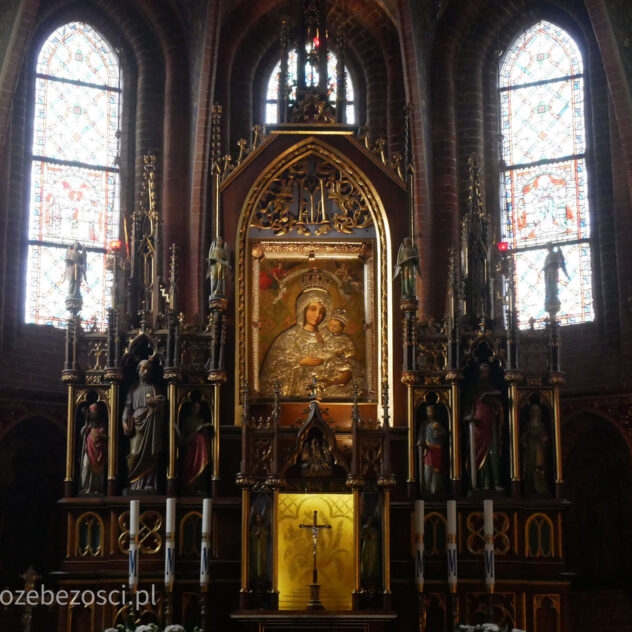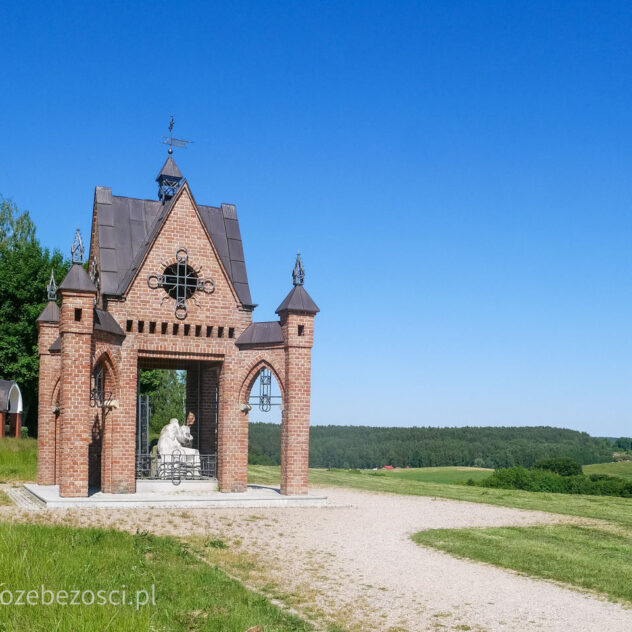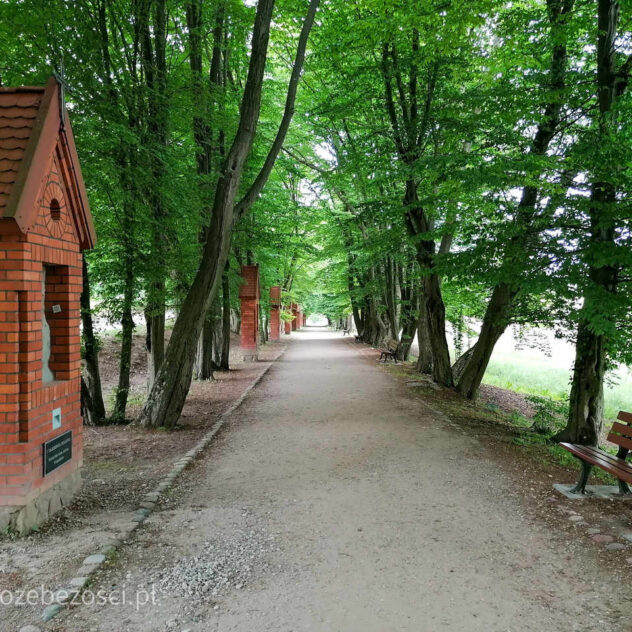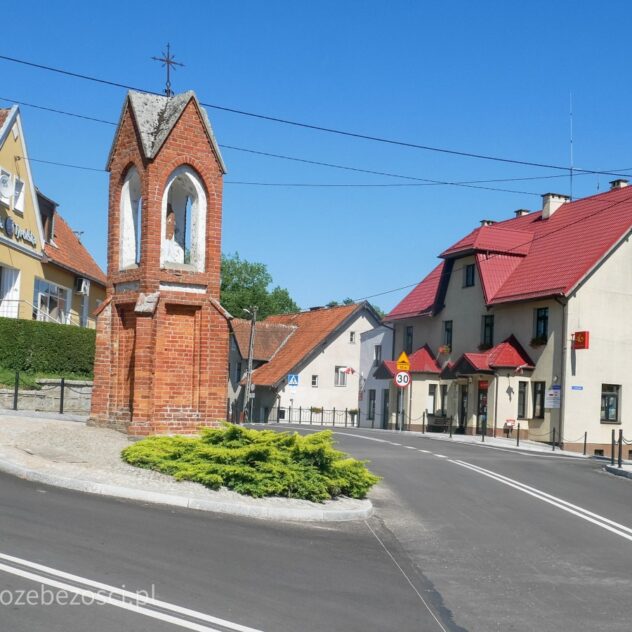Sanctuary of Our Lady of Gietrzwałd
Information about the pilgrimage site
Gietrzwałd lies between Ostróda and Olsztyn, on the edge of southern Warmia, surrounded by small hills on the Giłwa River, a right tributary of the Pasłęka. On 19 May 1352 the Warmian Cathedral Chapter issued a foundation charter to the settlement.
Initially, a wooden chapel was erected on the hill and, very likely, a parish was established at the same time. The first known parish priest was Jan Sternchen (1405-1409). During the Polish-Teutonic war of 1410-1414, the village and the chapel were destroyed. In the 15th century, a single-nave Gothic church was erected, dedicated to the Nativity of the Blessed Virgin Mary, which was consecrated on 31 March 1500 by Bishop Jan Wilde, suffragan of Warmia.
The church has been rebuilt several times. The first major renovation and adaptation of the church to the Renaissance style was carried out at the end of the 16th century. Later, during the Baroque period, the church was equipped with new altars. On 11 June 1790, Bishop Ignacy Krasicki gave the temple two new titles: Saint John the Evangelist and Saint Apostles Peter and Paul. In the 19th century, the parish priest Jozef Jordan (1863-1869) led to the expansion of the church, strengthening the foundations and walls.
Gietrzwald became famous for the Apparitions of Our Lady, which lasted from 27 June to 16 September 1877. The main visionaries were thirteen-year-old Justyna Szafrynska and twelve-year-old Barbara Samulowska. Both came from indigent Polish families. Our Lady spoke to them in Polish, as Father Franciszek Hipler emphasised, “in the language they speak in Poland”. Our Lady, when asked by the girls: who are you? She replied: “I am the Blessed Virgin Mary Immaculately Conceived.” When asked what do you wish Our Lady? the answer was: “I wish you to pray the rosary every day!”
On 13 August 1945, the care of the Gietrzwald shrine was entrusted to the Order of Canons Regular of the Lateran.
Between 1966 and 1968, the old dilapidated fence was demolished and a new stone wall with metal-wrought spans, granite steps and a stone and cement walkway were built around the church. Prior to the celebrations of the 100th anniversary of Our Lady’s apparitions, the architecture and interior of the church were renovated, a new marble floor was laid and the polychrome was renewed. Fifteen new rosary shrines were erected along the hornbeam lane leading to the spring by sculptor Julian Kasprzycki of Myślenice to a design by architect Sylwester Kwiatkowski of Bialystok.
By virtue of a bull of Pope Paul VI of 2 February 1970, the church of Gietrzwald was given the title of basilica minor.
Tourist attractions in the vicinity
Gietrzwałd Gardens – the gardens were created in the centre of the village and are an interesting recreational area. Here you will find, among other things, a garden on a hill with an amphitheatre, a garden by the river, i.e. a green walkway or a market boulevard. The riverside boulevard is also impressive, i.e. a walking path with a viewing bay and a beautiful new bridge over the River Gilva. In addition, there is a canoe pier, viewing platforms and terraces, a fountain with a water feature, unique sculptures, a children’s playground or a place for a family barbecue. The walkway is accessible for wheelchairs and prams.
Rosary avenue – prior to the celebrations of the 100th anniversary of Our Lady’s apparitions, the architecture and interior of the church were renovated, a new marble floor was laid and the polychrome was renewed. Fifteen new rosary shrines were erected along the hornbeam avenue leading to the spring by sculptor Julian Kasprzycki of Myślenice to a design by architect Sylwester Kwiatkowski of Bialystok.
Many pilgrims, walking along the lane leading to the spring, pray the Rosary as Our Lady wished during the Apparitions of Gietrzwald in 1877. They stop at successive stations to meditate on the mysteries of the Rosary.
Miraculous spring – from the beginning of the apparitions, the girls asked Our Lady if the sick pilgrims arriving would experience healing. Our Lady promised that people would receive the grace of healing, but that prayer, penance and often a Mass celebrated for the intention of the sick person was needed. On 8 September 1877, the Blessed Virgin Mary promised to bless a spring on parish land below the forest.
To avoid confusion and crowding, no notice was given to the pilgrims. At seven o’clock in the evening the visionaries, priests and several lay people went to the spring. At the spring, the Angelus was recited to the sound of the church bell, followed by the Litany of Loretto, during which the visionaries had an apparition. Our Lady was then to bless the spring and all those present. After singing the Salve Regina, O Sanctissima and the Magnificat, everyone returned to the front of the church for the Rosary service. Pilgrims have been drawing water from it for years, which has brought relief to the suffering and numerous healings. The act of blessing itself was immortalised with a statue of the Immaculate Virgin.
The water was conducted into a stone well and three marble reliefs were placed over the spring, showing Moses touching the rock from which the water gushed out with his staff and the Israelites drinking the water in the desert.
Stations of the Cross – completed only in 2007, the monumental Stations of the Cross at Gietrzwald are an undoubted highlight of this shrine. The stations, carved by Jan Stępkowski of Strzegowo, are housed in tasteful chapels and lead from the place of revelations and the spring to the hill above the sanctuary. The entirety of the brick-and-cream chapels is quite impressive. From station XIV, there is a beautiful view of the sanctuary. The builder of the first station was the tragically deceased Jan Kotkowski, and the designer of the shrines was Marcin Dutko.
Deskals by Arkadiusz Andrejkow – in 2022, Gietrzwałd celebrated the 670th anniversary of the village’s foundation. On this occasion, three unusual deskals were created. They were created by Arkadiusz Andrejkow from Sanok, who is famous for painting unusual pictures on the old wooden walls of houses or barns. Most often, these are scenes from old photographs depicting the former owners, neighbours and inhabitants of the area. Similar ones can be seen in Gietrzwald.
The descales show scenes from old photographs from family albums that commemorate former Warmia. They show the barn owner and her friend dressed in Warmian costumes, a carriage carrying the brother of a villager and his children, and a childhood friend of the barn owner riding a bicycle. Each painting is accompanied by a plaque with a description in Polish, English and German.
The planks can be found by the entrance road from Ostróda (ul. Ostródzka), by the municipal office (ul. Szkolna), and by the road towards Olsztyn (ul. Olsztyńska). They were funded from a public collection in which, in addition to residents, business people and friends of Gietrzwald took part.
The Evangelical-Augsburg Church in Łęguty is the only Evangelical church in the municipality of Gietrzwałd. It is located in a small village of Łęguty situated on the western side of the Pasłęka River, i.e. in Masuria. The Baroque temple from 1738 has survived almost unchanged and services are still held there. The inconspicuous and modest building hides an interesting interior. Unusual is the amphitheatre-like positioning of the pews, which are lowered towards the altar. The altar itself may also surprise you, as it is connected to the pulpit. The Baroque painting of the Last Supper, the painting depicting the Crucifixion and the baptismal font have survived from the original furnishings. Plaques commemorating the inhabitants’ participation in the Prussian Wars and the First World War hang on the side walls of the church.
The cemetery next to the church is worth a visit, with tombstones, cast-iron crosses and wrought-iron fences typical of the region. There is also a historic metal bell tower with a bell from 1805. The church is usually closed and to visit it, you should arrive around the time of the service, or contact the Evangelical-Augsburg Parish in Ostróda. For more information http://ostroda.luteranie.pl.
Other tourist attractions in the vicinity of the pilgrimage site can be found on the Gietrzwad tourist information website: http://it.ckbgietrzwald.pl/.
Accommodation
- Accommodation for pilgrims: Domus Mariae Retreat House (https://domusmariae.eu/ ), the Sanctuary of Our Lady of Gietrzwałd – Pilgrim’s House (https://sanktuariummaryjne.pl/page/55/dom-pielgrzyma) or the Sanctuary of Our Lady of Gietrzwałd – Training and Recreation Centre (https://sanktuariummaryjne.pl/page/56/orodek-szkoleniowo-wypoczynkowy)
- Various private accommodation options nearby.
Availability
By car
Access by car is the easiest. It can be reached almost in front of the Sanctuary itself, near which there is a car park where you can leave your car.
By public transport
Access by train: Gietrzwałd does not have a direct rail link. The nearest major railway stations are Olsztyn and Olsztynek. From these stations one can use public transport or hire a car to reach Gietrzwałd.
Getting there by bus: There are regular bus services to Gietrzwałd from larger cities in the region, such as Olsztyn, Gdańsk and Warsaw. Buses often run from bus stations or city centres, providing a relatively convenient travel option.
On foot
Gietrzwałd is surrounded by picturesque nature and is a suitable destination for walks and excursions. There are several hiking trails in the region; you can find them on the map.
On a bicycle
For those who enjoy active recreation, cycling can be an attractive option. Gietrzwałd is surrounded by picturesque countryside, which makes it an excellent destination for cycling. There are numerous cycle paths in the region, making it possible to travel by bicycle from nearby towns or villages.








